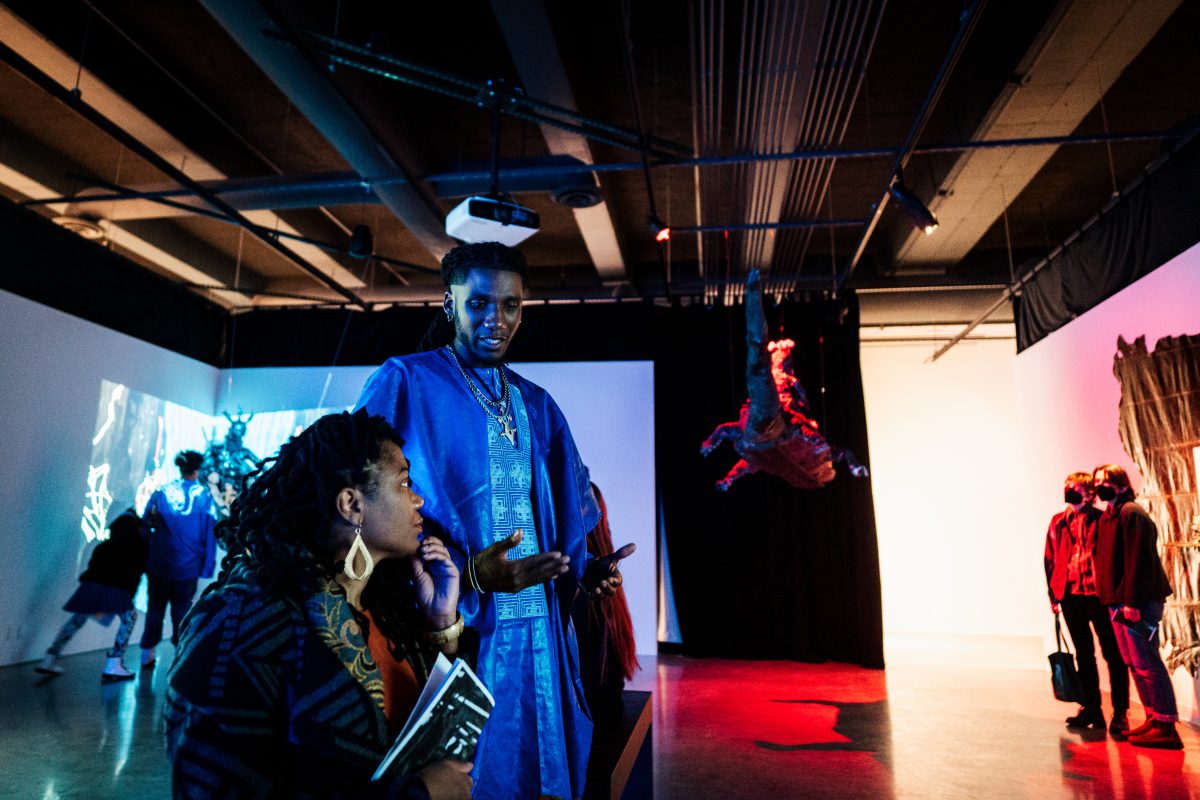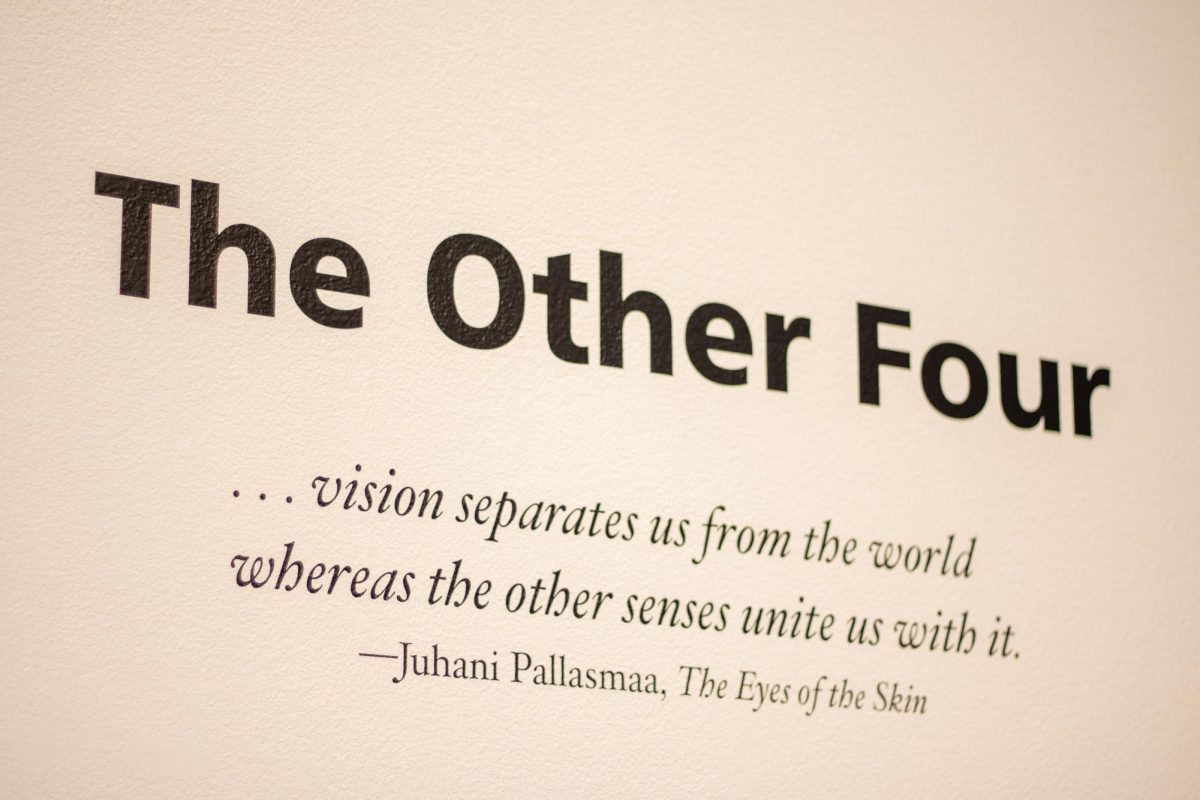khjTake a complex idea, and make it look simple. Students spend three years perfecting that craft through the University of Minnesota’s Graphic Design MFA program, but for many, it’s a work in progress.
“I spent a long time just staring at a paper or my computer screen and not getting anything done,” said Alicia Weller Thompson, one of the graduating MFA students. “I think that’s definitely part of the process.”
Graduates from the program will showcase their theses and ongoing thesis work at the Larson Art Gallery in St. Paul on Monday. The projects cover a variety of topics but are united by the rigorous effort necessary to synthesize ideas into visual presentations.
Thompson, who is also receiving a graduate minor in cognitive science, said her work focuses on “art in psychology” and visually portrays cognitive scientific concepts.
On the other hand, graduating MFA student Gordon McAlpin has a background in print design and cartooning but focused his degree on interactive design.
McAlpin’s interactive website educates people about Twin Cities movie theater strikes in the late 1920s, when theaters were transitioning from silent to sound. The website includes essays he wrote about the topic, both from the point of view of workers’ unions and that of big theater chains. He also incorporates primary source images from about 300 newspaper and journal clippings and historic photographs.
“I wanted to explore how you can use the web and any interactive presentation to present academic material, like a media history, differently than it can be done in print,” McAlpin said. “[Maybe we can] see if that’s something that can add to the experience or exploration of an academic narrative.”
In addition to presenting his thesis project, he’s also showing a work-in-progress of his long-running webcomic “Multiplex,” about life at the movies.
“Generally, I’m interested in storytelling, visual storytelling [and] electronic publishing,” McAlpin said
Thompson’s thesis project takes a more conceptual turn. Hers is a series of paintings that visually represent different configurations of theories of mind popular in cognitive science.
“I was interested how, in this field, there’s a lot of public interest right now in, ‘What is the brain?’ and, ‘What is the mind?’” Thompson said. “But there’s this big divide between [the interested populous] and the people who are academically engaged in the conversation.”
In academic arenas, she said, visualization of data is rare, which can impede laypeople’s efforts to understand the big cognitive concepts. In addition to representing scientific ideas artistically, Thompson was also interested in how the process of creating the work helped her own comprehension.
In her project, she illustrates the theory of “situated cognition,” which postulates that not all the thinking you do is in your brain but part of it is somewhere outside — that knowledge and action are inseparable.
“For that idea in particular, I have a kind of creature that’s made out of brain-like material and has animated neurons that are crawling on it all over its body,” Thompson said. “That represents the idea of the mind coming out.”
Graphic Design and MFA Thesis Show Opening Reception
Where Larson Art Gallery, 2017 Buford Circle, St. Paul
When 6-8 p.m. Monday
Cost Free
Take a complex idea, and make it look simple. Students spend three years perfecting that craft through the University of Minnesota’s Graphic Design MFA program, but for many, it’s a work in progress.
“I spent a long time just staring at a paper or my computer screen and not getting anything done,” said Alicia Weller Thompson, one of the graduating MFA students. “I think that’s definitely part of the process.”
Graduates from the program will showcase their theses and ongoing thesis work at the Larson Art Gallery in St. Paul on Monday. The projects cover a variety of topics but are united by the rigorous effort necessary to synthesize ideas into visual presentations.
Thompson, who is also receiving a graduate minor in cognitive science, said her work focuses on “art in psychology” and visually portrays cognitive scientific concepts.
On the other hand, graduating MFA student Gordon McAlpin has a background in print design and cartooning but focused his degree on interactive design.
McAlpin’s interactive website educates people about Twin Cities movie theater strikes in the late 1920s, when theaters were transitioning from silent to sound. The website includes essays he wrote about the topic, both from the point of view of workers’ unions and that of big theater chains. He also incorporates primary source images from about 300 newspaper and journal clippings and historic photographs.
“I wanted to explore how you can use the web and any interactive presentation to present academic material, like a media history, differently than it can be done in print,” McAlpin said. “[Maybe we can] see if that’s something that can add to the experience or exploration of an academic narrative.”
In addition to presenting his thesis project, he’s also showing a work-in-progress of his long-running webcomic “Multiplex,” about life at the movies.
“Generally, I’m interested in storytelling, visual storytelling [and] electronic publishing,” McAlpin said
Thompson’s thesis project takes a more conceptual turn. Hers is a series of paintings that visually represent different configurations of theories of mind popular in cognitive science.
“I was interested how, in this field, there’s a lot of public interest right now in, ‘What is the brain?’ and, ‘What is the mind?’” Thompson said. “But there’s this big divide between [the interested populous] and the people who are academically engaged in the conversation.”
In academic arenas, she said, visualization of data is rare, which can impede laypeople’s efforts to understand the big cognitive concepts. In addition to representing scientific ideas artistically, Thompson was also interested in how the process of creating the work helped her own comprehension.
In her project, she illustrates the theory of “situated cognition,” which postulates that not all the thinking you do is in your brain but part of it is somewhere outside — that knowledge and action are inseparable.
“For that idea in particular, I have a kind of creature that’s made out of brain-like material and has animated neurons that are crawling on it all over its body,” Thompson said. “That represents the idea of the mind coming out.”
Graphic Design and MFA Thesis Show Opening Reception
Where Larson Art Gallery, 2017 Buford Circle, St. Paul
When 6-8 p.m. Monday
Cost Free
















